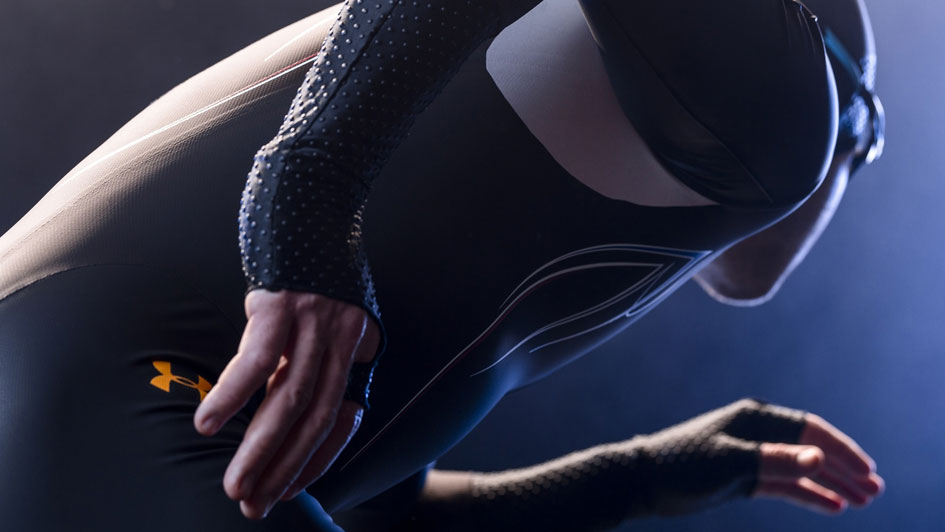
The U.S. Speedskating team has suffered a nightmare of under-performances at the Sochi Olympics. American skater, Brittany Bowe – the world’s second-ranked skater in the 1,500 – could hardly explain why she finished 14th. Her counterpart, Heather Richardson, also had a somber moment when she saw her time on the leaderboard and was so distressed that she sat down with her head buried in her hands.
Earlier, the long-track and short-track American speedskaters were projected to win 10 medals at Sochi, but eight events later there are none. Their performance is shocking – especially when you consider that speedskating has been the most successful Winter Games sport for the United States. At the 2010 Olympics, the United States took home 10 medals, four in long-track and six in short-track. Sport analysts and fans are wondering how this domination in a sport could end so abruptly. What could have changed expectations so much? Enter the Under Armour branded Mach 39 skating suits.
The skaters and coaches have been blaming design flaws in Under Armor’s suits for slowing them down. Under Armor had earlier branded the suits as the world’s fastest skins made with the latest hi-tech technology. For this reason, the United States coaches decided that athletes would wait until the Olympics to compete in them, so other teams would not have a chance to copy the designs. Makes sense in some ways. But when the athletes performed poorly, they did the only thing that made sense – they collectively switched back to the old suits they had worn during the World Cup season. Unfortunately, their performance did not improve. Meanwhile, the Dutch skating team was sweeping the medals and making history.
SEE ALSO: Change for Good: The Power of Design in Creating Our Future
Regardless if you find the argument that a piece of fabric on the speedskater’s suits was to blame for this poor performance credible – or thinner than the fabric of the suits themselves – the damage has already been done to the Under Armour brand. Truthfully, it is all hearsay on the part of the athletes themselves, since there is no real evidence from testing that shows the suits are to blame. However, they are the experts and they have fallen mightily and very publicly, so the world is listening.
There are certainly other logical factors that may have caused the speedskaters’ woes. To begin with, the team trained for the Olympics at altitude in Collalbo, Italy, instead of at sea level in Sochi. Brian Hansen’s coach, Nancy Swider-Peltz, indicated that she knew this was wrong and that it would take a toll on performance, but she didn’t voice her concerns. Too bad. We could also assume that a sense of fear was created after two athletes, who had failed to make podium, started blaming their suits for causing drag. A member of the Dutch team who had heard the rumors mentioned this to Shani Davis, who went ahead and told the American coaches that there was a problem. That is, when some of the skaters in the American team decided to revert to their old suits –pummeling the heavily-hyped Under Armour brand in the process.
Under Armour, which sponsors the U.S. Speedskaters and designs their suits, is obviously having a hard time. Its reputation for creating cool, technologically-advanced designs that merit high price tags is at stake. Some are pointing at the brand’s 2.4% stock price plunge on Friday as an indication that it is taking a beating from this controversy. So far, most of Under Armour’s PR moves have been exceptional, but they can do even more to limit further damage to the brand.
First, they should continue to respond by not blaming the skaters. This is paramount. The point here is that Under Armour should avoid reacting defensively – no matter how many times the skaters point fingers at them. Unfortunately, they have reacted by making many defensive comments about the suits, often citing the thorough testing process at their plants. Second, the brand must show that it is willing to always come to the aid of the speedskating team whenever they are needed. Again, this is of vital importance. Until now, Under Armour has been consulting on the ground to see if they can help the team, which is appropriate. The brand should also limit their response to the present context of the Sochi Olympics. No one wants other past chinks in their suits to be brought up at this critical moment. Although nothing can be done about the skaters’ lost dreams of glory, these moves collectively will go a long way to save the day – at least for the Under Armour brand.
SEE ALSO: The Olympic Brand vs. Putin’s Agenda
Fortunately, the brand does have significant PR capital to spend and they should use it wisely to wade through this storm. Considering the advance hype about the suits being the best speedskating outfits in the world, Under Armour should switch from bragging as they respond to criticism. Then, when the glare of the spotlight is off, the brand can go back to the labs and look at the uniforms under a microscope.
Controversies over athletic equipment and Olympic controversies happen every year and most disappear after a short while. However, some observers say that the speedskating team may lose their sponsor because of this incident. Under Armour did say that the company will, like with all of its sponsorship agreements, revisit its relationship with U.S Speedskating, which makes sense. Brand management and careful, fair responses by Under Armour are critical to ensure no further damage comes from this mess and determine what long-term effect Sochi will ultimately have on the red-hot Under Armour brand.